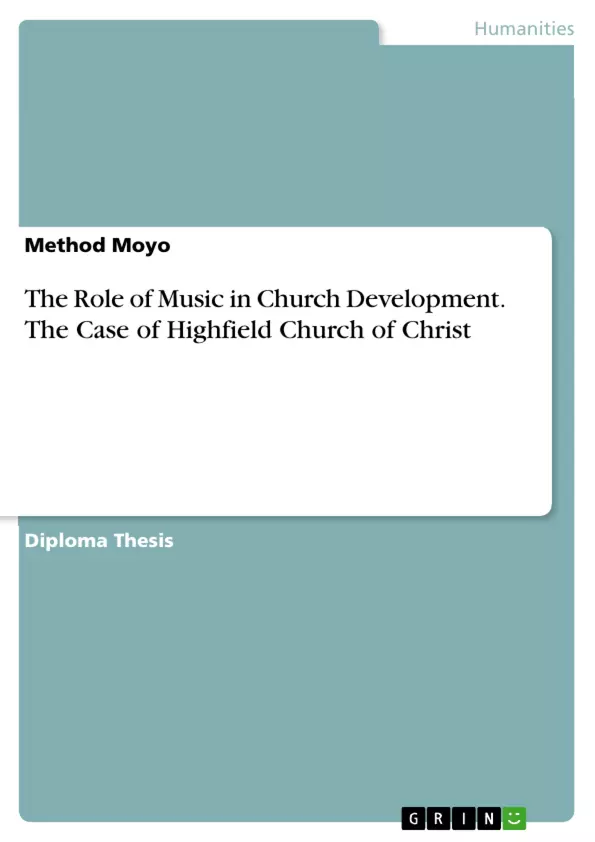It is undeniable that music plays a significant role in church development and growth. The main objective of this research was to explore the impact of music in facilitating development and growth in the church and used Highfield Church of Christ (HCOC) as a case study.
The research gives a brief summary of the history of HCOC as its view of music could have hardly been understood without first tracing the historical context. The research also traced the use of music in the Old Testament, New Testament, church history and in African Traditional Religion to see how the use of music during those ages impacts church music today.
The Natural Church Development (NCD) Model and the Bonsai Theory of Church Growth are theoretical frameworks which were used to inform the study. To collect data, the researcher used questionnaires, interviews and observation.
Inhaltsverzeichnis (Table of Contents)
- Dedication
- Acknowledgement
- List of Tables
- List of Figures
- Abbreviations
- Abstract
- CHAPTER 1: INTRODUCTION
- 1.0 Introduction
- 1.1 Background of the Study
- 1.2 Statement of the Problem
- 1.3 Research Questions
- 1.4 Research Objectives
- 1.5 Significance of the Study
- 1.6 Delimitations of the Study
- 1.7 Limitations of the Study
- 1.8 Assumptions
- 1.9 Overview of the Study
- 1.10 Definition of Terms
- CHAPTER 2: LITERATURE REVIEW
- 2.0 Introduction
- 2:1 Theories of Church Development
- 2.1.1 The Natural Church Development (NCD) Model
- 2.1.2 The Bonsai Theory of Church Growth
- 2.2 Understanding Church Music
- 2.3 Music through the Ages
- 2.3.1 Music in the Old Testament
- 2.3.2 Music in the New Testament
- 2.3.3 Music in Church history
- 2.3.4 African Traditional Religion and music
- 2.4 Nature of COC Music
- 2.4.1 Hymns
- 2.4.2 Choruses
- 2.5 Music in Church Development
- 2.5.1 Music as an education tool
- 2.5.1.1 Children and music
- 2.5.1.2 Adults and music
- 2.5.2 Music and evangelism
- 2.5.3 Music and spiritual growth
- 2.5.4 Church unity through music
- 2.5.5 Edification through music
- 2.5.6 Healing Through Music
- 2.5.7 Maturation of Believers through Music
- 2.6 Development of Music Ministry
- 2.6.1 Developing Choral Groups
- 2.6.1.1 Muzambangwena Choral Group
- 2.6.1 Composition of new hymns
- 2.7 Conclusion
- CHAPTER 3: METHODOLOGY
- 3.0 Introduction
- 3.1 Methodology
- 3.1.1 Qualitative Research
- 3.1.2 Quantitative Research
- 3.2 Research Design
- 3.2.1 Case Study
- 3.3 Research Method and Tools
- 3.3.1 Questionnaires
- 3.3.2 Interviews
- 3.3.3 Observation
- 3.3.4 Documents Analysis
- 3.4 Population
- 3.5 Sample
- 3.6 Data Collection
- 3.7 Data Presentation and Analysis
- 3.8 Reliability and Validity
- 3.9 Ethics
- 3.10 Conclusion
- CHAPTER 4: DATA PRESENTATION AND ANALYSIS
- 4.0 Introduction
- 4.1 Response Rate
- 4.2 Demography
- 4.3 Music in the life of the church
- 4.3.1 Data from questionnaires
- 4.3.1.1 Importance of music in the life of the Church
Zielsetzung und Themenschwerpunkte (Objectives and Key Themes)
This research aims to explore the role of music in the development of Highfield Church of Christ. It examines the church's use of music in various aspects of its operations, including education, evangelism, spiritual growth, and church unity. The research seeks to understand how music has contributed to the growth and development of the church over time.
- The impact of music on church development
- The role of music in education, evangelism, and spiritual growth
- The significance of music in fostering church unity and edification
- The influence of African traditional music on contemporary church music
- The historical and theological perspectives of music in the Christian context
Zusammenfassung der Kapitel (Chapter Summaries)
Chapter 1 introduces the research, providing background information on Highfield Church of Christ and outlining the research problem, questions, objectives, and significance. It also defines key terms and clarifies the scope of the study.
Chapter 2 delves into the literature review, exploring theories of church development, the nature of church music, and its historical and theological context. It examines how music has been used for education, evangelism, and spiritual growth in various Christian traditions, including African churches.
Chapter 3 details the methodology employed for the research. It discusses the research design, methods, tools, data collection procedures, and ethical considerations.
Chapter 4 presents and analyzes the data gathered through questionnaires, interviews, observations, and document analysis. It explores the demographics of the church community, the role of music in their lives, and its impact on the church's development.
Schlüsselwörter (Keywords)
This research focuses on the role of music in church development, specifically examining the case of Highfield Church of Christ. Key themes include church music, evangelism, spiritual growth, church unity, African traditional religion, and the historical and theological perspectives of music in the Christian context.
- Citation du texte
- Method Moyo (Auteur), 2022, The Role of Music in Church Development. The Case of Highfield Church of Christ, Munich, GRIN Verlag, https://www.grin.com/document/1297641



